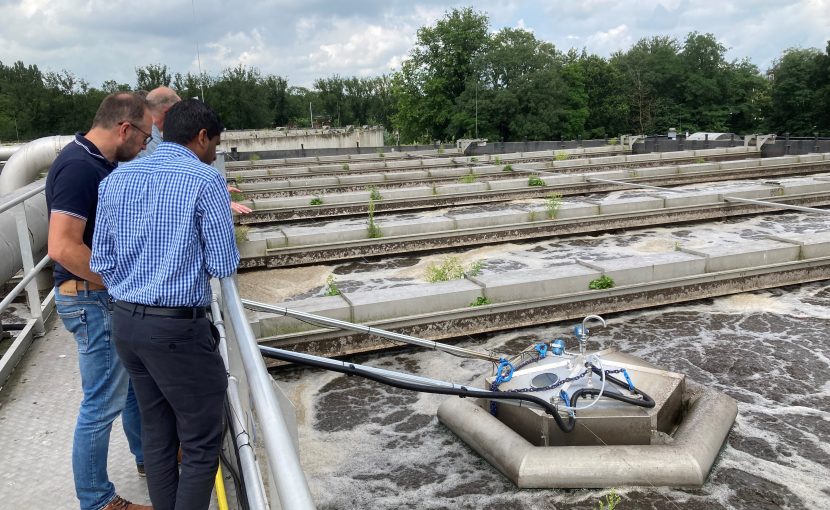
Reducing emissions or negative impact
Make the system more circular by tackling negative impact and emissions
An ideal circular system has no emissions and no negative impact on our living environment nor on ourselves – in fact, it may even have a positive impact. As we proceed on the path to such circular systems, we also strive to prevent, or to minimise, the negative impact of the emissions. In the meantime, we gain more and more insight into emissions that are generated in different processes, and their possible effects on ourselves and our living environment. These emissions range from greenhouse gasses (CO2, CH4, N2O) to concentrate (brine), and from pharmaceutical residues to other micropollutants. With better insight into the current emissions, and how we can deal with them, we can carry out well-grounded searches for solutions for the removal of toxic substances or, better still, for the prevention of their release.
Methods, tools and products
The processing and valorisation of membrane and other concentrate contributes for instance to a (near) zero pollution in the water sector, and provides a stimulus for the circular economy. The removal of undesirable substances can be accomplished, for example, by concentrating the substances in brine. In the case of truly undesirable substances, which we do not want to, or cannot (yet), reuse, we opt rather for effective collection and processing.
Projects
Monitoring, modelling and reducing nitrous oxide emissions from WWTPs
Industry and society are striving to reduce the carbon footprint and thereby mitigate climate change. But carbon dioxide is not the only harmful greenhouse gas: nitrous oxide (N2O) has a global warming potential (GWP) that is even 273 times greater than that of CO2. Wastewater treatment plants (WWTPs) are a significant source of N2O emissions. We work on mitigation strategies for WWTPs through intensive monitoring and modelling of N2O emissions. With the knowledge we develop, end-users can evaluate how different mitigation strategies can minimise N2O emissions from their treatment plants.
Calculation of drinking water utilities’ CO2 footprint
An Operational Code for CO2 Footprint Calculation has been developed for drinking water utilities. With this Operational Code, the drinking water sector wishes to formalise the calculation in order to achieve greater uniformity and consistency in the calculation method. Since the code is seen as a proposal, the drinking water utilities can interpret it according to their situation, selecting those elements they include or exclude in their calculation. This flexibility also makes possible the phased introduction of certain elements into the calculation, which could be needed, for example, because the tools for an exact quantification are not yet available.
Exploration of climate-neutrality in the water cycle at the tactical and strategic level
Water utilities have formulated different ambitions and objectives with regard to achieving a climate-neutral water cycle. In the first instance, these ambitions target the drinking-water part of the water cycle, but, in a number of cases, they reach further and, for example, encompass households as well. The latter example is based on their awareness that the highest levels of energy consumption in the water cycle take place in peoples’ homes. The water utilities can learn a lot from each other by becoming better informed about different methods used and the anchoring of CO2 emission reduction.
Exploratory Research: Water Quality Footprint
The water sector is working on CO2 emission reduction and climate neutrality. Up until now, the possibility of including water quality improvement in environmental impact methodologies has however been very limited. Thus, while the treatment efforts to remove pharmaceutical residues and micropollutants from the water are indeed included in the CO2 footprint calculation, (unjustifiably) no positive environmental impact is granted for the result, namely: improved water quality. This can lead to an inaccurate assessment of innovations, which, even if they are not actually associated with reduced CO2 emissions, do in fact result in improved water quality. We are developing a methodology aimed at having the wider environmental impact gradually incorporated into the total environmental impact analysis..
Opportunities for Concentrate
In this project we are investigating how the circular processing of concentrated residual streams can contribute to a future-resilient and a socially responsible freshwater provision. This involves recovering water and producing raw materials for which there is a market.
Managing concentrate streams
An increasing number membrane techniques are being implemented in water treatment, so that the management of concentrate streams has also become increasingly important. Concentrate management is often an obstacle for the implementation of membrane techniques. This explains why KWR was commissioned by the water utilities to produce a survey of the current status of concentrate stream management in drinking water treatment processes.